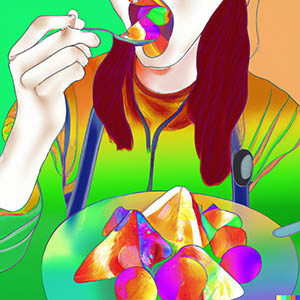Taste-color synesthesia
Taste-color synesthesia is a fascinating and unique condition that has long intrigued researchers and the general public alike. In this article, we will explore the world of taste-color synesthesia, its possible causes, and its effects on individuals who experience it.
What is Taste-Color Synesthesia?
Taste-color synesthesia is a type of synesthesia where individuals experience colors when they taste different foods or drinks. For example, someone with taste-color synesthesia might perceive the taste of a lemon as bright yellow or the taste of chocolate as dark brown. These associations are automatic and involuntary, meaning that the individual experiences them without conscious effort or intention.
The experience of taste-color synesthesia varies from person to person. Some individuals may experience a specific color for a certain taste, while others may experience a range of colors or even a swirl of colors. Some people may experience the same color for multiple tastes, while others may have completely different associations.

Possible Causes of Taste-Color Synesthesia
The exact cause of taste-color synesthesia is not yet fully understood. However, some researchers believe that it may be due to cross-activation between the brain regions responsible for processing taste and color perception.
The taste buds on our tongue send signals to the gustatory cortex in our brain, which is responsible for processing taste information. Similarly, our eyes send signals to the visual cortex, which is responsible for processing visual information. It is possible that in individuals with taste-color synesthesia, there is an overlap or cross-activation between these brain regions, leading to the perception of colors when tasting different foods.
It is also possible that taste-color synesthesia is due to a heightened sensitivity to the emotional or cultural associations we have with different tastes. For example, the color yellow is often associated with happiness or brightness, so it is possible that someone with taste-color synesthesia may associate the taste of a lemon with the color yellow because of this cultural association.
Effects of Taste-Color Synesthesia
Taste-color synesthesia is a relatively rare condition, with only a small percentage of the population experiencing it. However, for those who do experience it, it can have a profound impact on their perception of the world around them.
One potential effect of taste-color synesthesia is an increased sensitivity to taste and flavor. People with this type of synesthesia may be able to detect subtle differences in taste that others may not notice. They may also be more discerning when it comes to their food choices, preferring certain flavors or combinations of flavors based on the colors they perceive.
Taste-color synesthesia can also affect an individual's memory and creativity. Because the associations between tastes and colors are automatic and involuntary, they may be more likely to remember specific tastes or food experiences based on the colors they perceive. This can also lead to increased creativity in cooking or food presentation, as individuals with this type of synesthesia may be more likely to experiment with color combinations in their dishes.
Challenges of Taste-Color Synesthesia
One of the most significant challenges of taste-color synesthesia is that it can be distracting and overwhelming. When someone with this type of synesthesia is eating a meal or drinking a beverage, the colors they experience can be so vivid and intense that it can make it difficult for them to focus on the taste and texture of the food. This can lead to a sense of sensory overload, making it hard to fully enjoy the experience of eating or drinking.
In some cases, taste-color synesthesia can also be a hindrance when it comes to social situations. For example, if someone with this condition is out at a restaurant with friends or family, they may find it challenging to engage in conversation or focus on the social interaction because they are so focused on the colors they are experiencing in response to the food they are eating. This can lead to feelings of isolation and frustration, as well as difficulty forming connections with others.
Another challenge of taste-color synesthesia is that it can be unpredictable. While some individuals may experience consistent colors in response to certain tastes or flavors, others may find that their synesthetic experiences change over time. For example, they may associate the taste of coffee with the color brown one day, but the color purple the next. This can make it difficult to navigate daily life, as someone with taste-color synesthesia may have to constantly adjust to new and changing synesthetic experiences.
Additionally, taste-color synesthesia can be a source of confusion or misunderstanding for those who don't have the condition. Because it is such a rare form of synesthesia, many people may not be familiar with it or understand what it entails. This can lead to feelings of isolation or judgment from others, as well as a lack of awareness and support for those who have the condition.
Despite these challenges, taste-color synesthesia can also have some positive aspects. Many individuals with this condition report that it enhances their enjoyment of food and can even make eating a more exciting and pleasurable experience. Some may even use their synesthetic experiences to create unique and creative food combinations, or to explore new flavors and tastes.
There is also a growing community of individuals with taste-color synesthesia who connect and share their experiences online. These communities can provide a sense of understanding, support, and validation for those with the condition, as well as a platform for creativity and self-expression.